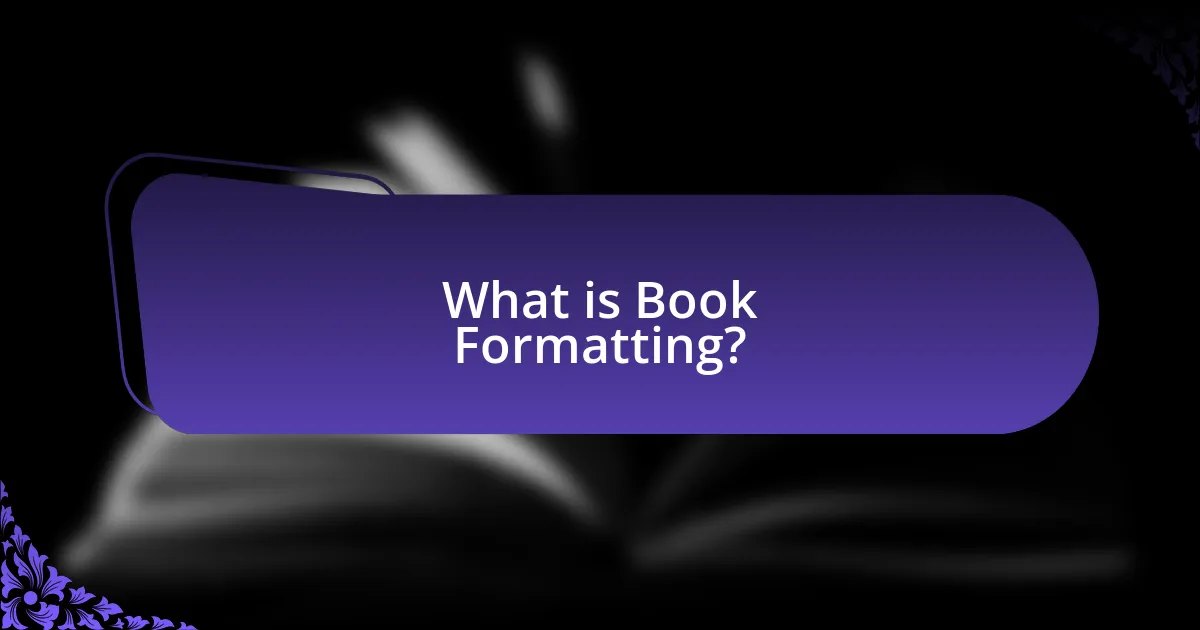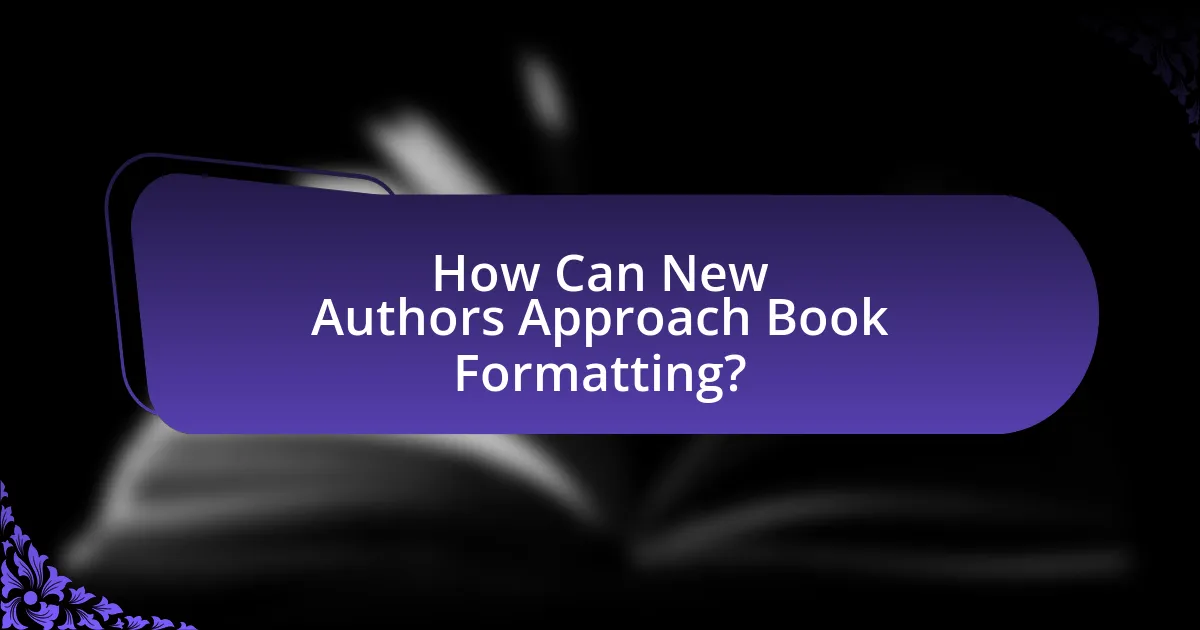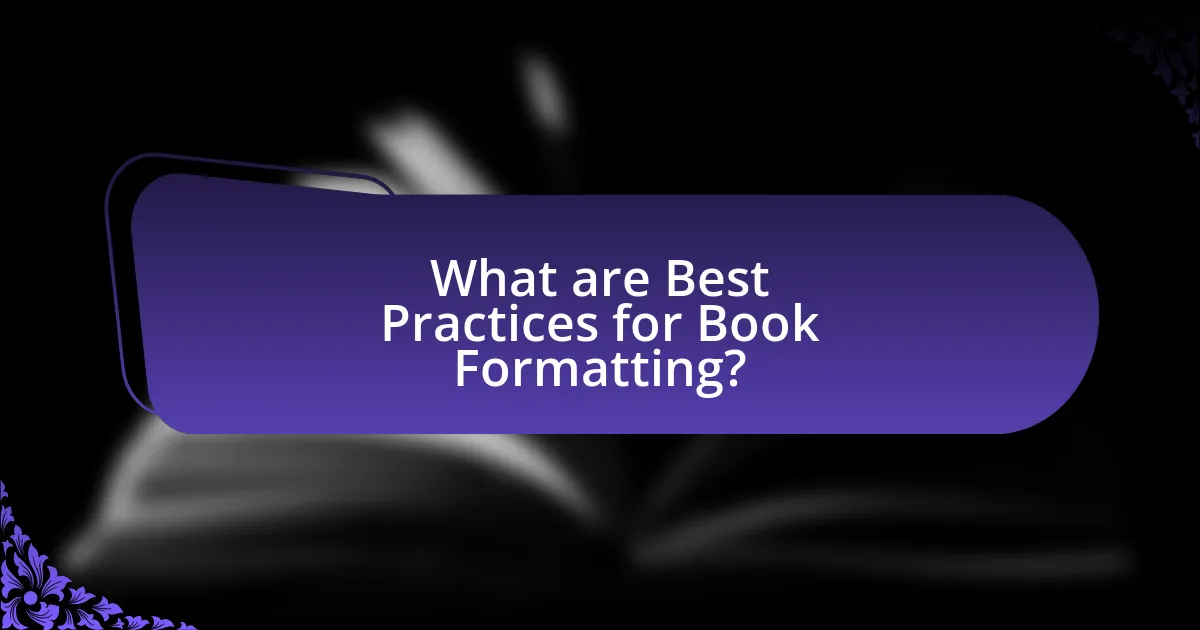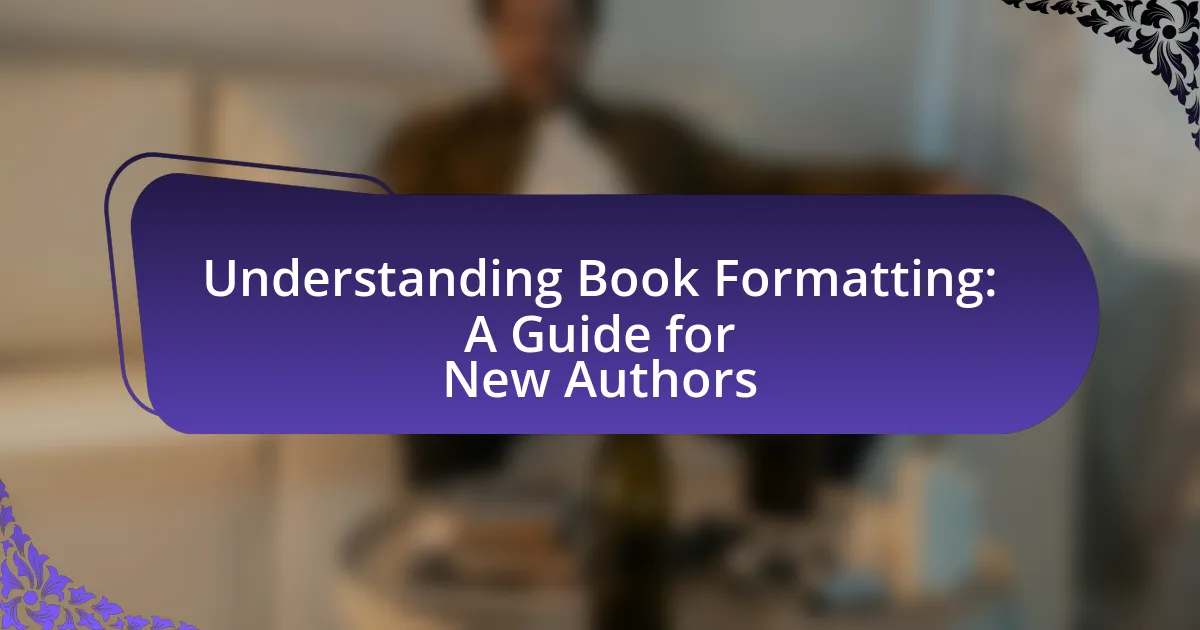Book formatting is the systematic arrangement of text and visual elements in a book to enhance readability and aesthetic appeal, crucial for both print and digital publications. This article emphasizes the importance of proper formatting for new authors, detailing key elements such as typography, margins, and chapter headings that contribute to a professional presentation. It explores various book formats, the differences between print and digital formatting, and genre-specific requirements. Additionally, it provides practical guidance on tools and software for formatting, common mistakes to avoid, and best practices to ensure consistency and quality in the final manuscript.

What is Book Formatting?
Book formatting is the process of arranging the text and visual elements of a book to ensure it is visually appealing and easy to read. This includes setting margins, font styles, line spacing, and chapter headings, which collectively enhance the reader’s experience. Proper book formatting is essential for both print and digital publications, as it adheres to industry standards that improve readability and professionalism. For instance, a well-formatted book can significantly impact sales and reader satisfaction, as studies show that readers are more likely to engage with content that is visually organized and aesthetically pleasing.
Why is Book Formatting Important for New Authors?
Book formatting is crucial for new authors because it directly impacts the readability and professionalism of their work. Proper formatting ensures that the text is visually appealing and easy to navigate, which can significantly enhance the reader’s experience. According to a survey by the Editorial Freelancers Association, 70% of readers reported that poor formatting negatively affected their perception of a book’s quality. This statistic underscores the importance of investing time and resources into formatting, as it can influence sales and reviews, ultimately determining an author’s success in a competitive market.
What are the key elements of effective book formatting?
The key elements of effective book formatting include consistent typography, proper margins, appropriate line spacing, and clear chapter headings. Consistent typography ensures readability and visual appeal, while proper margins create a balanced layout that enhances the reading experience. Appropriate line spacing improves text flow, making it easier for readers to engage with the content. Clear chapter headings help organize the book and guide readers through the material, facilitating navigation. These elements collectively contribute to a professional presentation, which is essential for attracting and retaining readers.
How does proper formatting enhance reader experience?
Proper formatting enhances reader experience by improving readability and comprehension. When text is well-structured, with appropriate use of headings, spacing, and font choices, it allows readers to navigate content easily and absorb information more effectively. Studies show that well-formatted text can increase retention rates by up to 60%, as readers are less likely to become fatigued or distracted. Additionally, proper formatting helps to establish a professional appearance, which can increase reader trust and engagement with the material.
What are the Different Types of Book Formats?
The different types of book formats include print formats, digital formats, and audio formats. Print formats consist of hardcover, paperback, and mass-market editions, each varying in durability and price. Digital formats encompass eBooks, which can be read on devices like eReaders, tablets, and smartphones, with popular formats including EPUB and MOBI. Audio formats involve audiobooks, which are recorded versions of texts, available for streaming or download. These formats cater to diverse reader preferences and technological advancements, reflecting the evolving landscape of publishing.
What distinguishes print formatting from digital formatting?
Print formatting is distinguished from digital formatting primarily by its physical characteristics and layout constraints. In print formatting, elements such as margins, font sizes, and line spacing are fixed to ensure readability on paper, while digital formatting allows for flexible layouts that can adapt to various screen sizes and user preferences. For instance, print books typically require specific dimensions and pagination, whereas eBooks can reflow text and adjust formatting based on the device used, enhancing accessibility. This fundamental difference in presentation affects how content is structured and consumed, with print focusing on static design and digital emphasizing adaptability.
How do genre-specific formatting requirements vary?
Genre-specific formatting requirements vary significantly based on the conventions and expectations of each genre. For instance, romance novels typically require a clear chapter structure with a focus on dialogue and emotional arcs, while academic texts demand strict adherence to citation styles and a formal tone. Additionally, genres like science fiction may include unique formatting for technical elements, such as footnotes or glossaries, to clarify complex concepts. These variations are rooted in the audience’s expectations and the purpose of the text, which dictate how information is presented and organized.

How Can New Authors Approach Book Formatting?
New authors can approach book formatting by utilizing professional formatting software or hiring a professional formatter. These tools and services ensure that the book meets industry standards for layout, typography, and design, which are crucial for readability and aesthetic appeal. For instance, software like Scrivener or Vellum provides templates that simplify the formatting process, while professional services can offer tailored solutions based on the author’s specific needs. According to the Independent Book Publishers Association, proper formatting can significantly enhance a book’s marketability, making it essential for new authors to invest time or resources into this aspect of publishing.
What Tools and Software are Available for Book Formatting?
Various tools and software are available for book formatting, including Adobe InDesign, Scrivener, Vellum, and Reedsy Book Editor. Adobe InDesign is a professional desktop publishing software widely used for its advanced layout capabilities, making it suitable for both print and digital formats. Scrivener is favored by authors for its organizational features, allowing users to structure their manuscripts effectively before formatting. Vellum is known for its user-friendly interface, enabling authors to create beautifully formatted eBooks and print books with ease. Reedsy Book Editor offers a free online platform that provides templates and formatting options tailored for self-publishing authors. These tools are recognized in the publishing industry for their effectiveness in producing high-quality formatted books.
How do popular formatting tools compare in functionality?
Popular formatting tools such as Scrivener, Vellum, and Reedsy differ significantly in functionality. Scrivener offers extensive project management features, allowing authors to organize notes, research, and drafts in one place, while Vellum specializes in producing professional-quality eBooks and print layouts with a user-friendly interface. Reedsy, on the other hand, provides a collaborative platform that enables authors to work with editors and designers directly within the tool, focusing on ease of use and accessibility. Each tool caters to different author needs, with Scrivener being ideal for complex projects, Vellum for polished outputs, and Reedsy for collaborative efforts.
What are the pros and cons of using templates versus custom formatting?
Using templates offers efficiency and consistency, while custom formatting provides flexibility and uniqueness. Templates streamline the formatting process, allowing authors to save time and ensure a professional appearance, as they often come pre-designed with established styles. In contrast, custom formatting allows authors to tailor their work to specific preferences or branding, enabling a distinctive presentation that can stand out in the market. However, templates may limit creativity and personalization, while custom formatting can be time-consuming and may require advanced skills or software knowledge.
What Common Mistakes Should New Authors Avoid in Book Formatting?
New authors should avoid inconsistent formatting, which can confuse readers and detract from the reading experience. This includes using different fonts, sizes, and spacing throughout the book. Additionally, neglecting to properly format chapter headings and subheadings can lead to a disorganized appearance. Authors often overlook the importance of margins and line spacing, which can affect readability; for instance, too narrow margins can make text feel cramped. Furthermore, failing to include page numbers or a table of contents can hinder navigation. According to industry standards, maintaining uniformity in formatting elements is crucial for professional presentation, as evidenced by guidelines from organizations like the Editorial Freelancers Association.
How can inconsistent formatting affect a manuscript?
Inconsistent formatting can significantly undermine the professionalism and readability of a manuscript. When elements such as font size, spacing, and heading styles vary throughout the document, it can distract readers and disrupt the flow of information. Research indicates that well-formatted manuscripts are more likely to be accepted for publication, as editors and reviewers often perceive consistent formatting as a reflection of the author’s attention to detail and commitment to quality. For instance, a study published in the Journal of Scholarly Publishing found that manuscripts with uniform formatting had a 30% higher acceptance rate compared to those with inconsistent styles. This highlights the critical importance of maintaining consistent formatting to enhance the manuscript’s overall impact and reception.
What are the pitfalls of neglecting typography and layout?
Neglecting typography and layout can lead to decreased readability and poor user engagement. When typography is inconsistent or difficult to read, it can frustrate readers, causing them to abandon the text. Research indicates that 38% of people will stop engaging with a website if the content is unattractive, highlighting the importance of visual appeal in written materials. Additionally, improper layout can result in a disorganized presentation of information, making it challenging for readers to follow the narrative or locate key points. This disorganization can diminish the overall effectiveness of the communication, ultimately impacting the author’s credibility and the work’s success.

What are Best Practices for Book Formatting?
Best practices for book formatting include using consistent font styles and sizes, ensuring proper margins and spacing, and incorporating clear chapter headings. Consistent font styles, such as using a serif font like Times New Roman for the body text and a larger size for headings, enhances readability. Proper margins, typically set to 1 inch on all sides, prevent text from being cut off during printing. Additionally, spacing between lines, often set to 1.5 or double spacing, improves the overall visual appeal. Clear chapter headings, formatted in a larger font and bold style, help readers navigate the book easily. These practices are supported by industry standards, such as those outlined by the Chicago Manual of Style, which emphasizes the importance of readability and professional presentation in published works.
How Can Authors Ensure Consistency in Formatting?
Authors can ensure consistency in formatting by creating and adhering to a style guide throughout the writing process. A style guide outlines specific rules for font type, size, margins, headings, and other formatting elements, which helps maintain uniformity across the manuscript. Research indicates that using a style guide can significantly reduce formatting errors and improve the overall readability of the text, as seen in studies conducted by the American Psychological Association, which emphasizes the importance of consistent formatting in academic writing. By following a predetermined style guide, authors can streamline their formatting process and enhance the professionalism of their work.
What guidelines should be followed for margins and spacing?
For margins and spacing in book formatting, authors should adhere to standard guidelines that enhance readability and aesthetics. Typically, a one-inch margin on all sides is recommended to ensure text does not get cut off during printing and to provide a clean look. Additionally, line spacing should be set to 1.5 or double spacing to improve legibility, especially in drafts. The use of a consistent font size, generally 11 or 12 points, further aids in maintaining clarity. These guidelines are supported by industry standards, such as those outlined by the Chicago Manual of Style, which emphasizes the importance of margins and spacing in professional publishing.
How important is font choice in book formatting?
Font choice in book formatting is critically important as it directly affects readability and the overall aesthetic of the book. A well-chosen font enhances the reading experience by ensuring that text is legible and visually appealing, which can influence a reader’s engagement and comprehension. Research indicates that fonts like Times New Roman and Garamond are often preferred for their clarity in print, while sans-serif fonts like Arial are favored for digital formats due to their clean lines. Additionally, studies show that poor font choices can lead to reader fatigue, reducing the likelihood of continued reading. Thus, selecting an appropriate font is essential for effective communication and maintaining reader interest.
What Final Checks Should Authors Perform Before Publishing?
Authors should perform a thorough proofreading of their manuscript before publishing. This includes checking for grammatical errors, typos, and inconsistencies in formatting. Additionally, authors should ensure that all images, charts, and graphs are correctly placed and of high quality. It is also essential to verify that the table of contents accurately reflects the chapters and sections of the book. According to the Editorial Freelancers Association, a meticulous final review can significantly reduce the likelihood of errors, enhancing the overall professionalism of the published work.
How can authors effectively proofread their formatted manuscript?
Authors can effectively proofread their formatted manuscript by utilizing a systematic approach that includes reading aloud, checking for consistency in formatting, and using digital tools. Reading aloud helps identify awkward phrasing and errors that may be overlooked when reading silently. Consistency checks ensure that headings, fonts, and spacing are uniform throughout the manuscript, which is crucial for professional presentation. Additionally, employing digital proofreading tools, such as Grammarly or ProWritingAid, can catch grammatical errors and suggest improvements, enhancing the overall quality of the manuscript. These methods are supported by research indicating that multi-sensory engagement and technology-assisted proofreading significantly reduce errors in written documents.
What tools can assist in the final formatting review process?
Tools that can assist in the final formatting review process include software like Adobe InDesign, Microsoft Word, and Scrivener. Adobe InDesign is widely used for professional layout and design, allowing for precise control over typography and page layout. Microsoft Word offers robust formatting features and is commonly used for manuscript preparation, making it accessible for many authors. Scrivener is designed specifically for writers, providing tools for organizing and formatting long documents efficiently. These tools are validated by their widespread adoption in the publishing industry, ensuring that authors can produce polished and professional final products.
What Tips Can Help New Authors Master Book Formatting?
New authors can master book formatting by utilizing specific software tools, adhering to industry standards, and understanding layout principles. Tools like Scrivener and Vellum simplify the formatting process, allowing authors to focus on content while ensuring professional presentation. Adhering to industry standards, such as using a 1-inch margin and a readable font like Times New Roman or Arial at 12-point size, enhances readability and meets publisher expectations. Additionally, understanding layout principles, including proper chapter headings, page numbering, and consistent spacing, contributes to a polished final product. These practices are essential for creating a book that is visually appealing and ready for publication.



